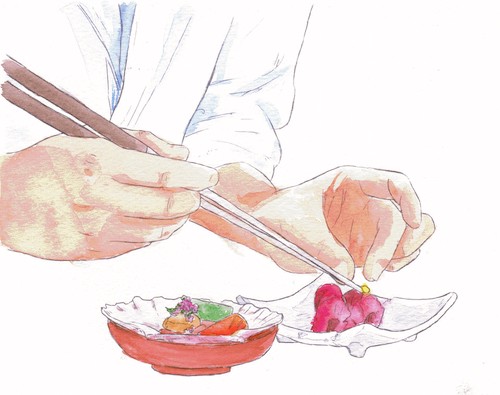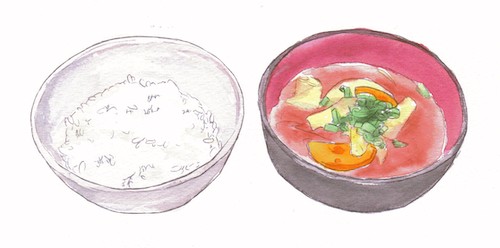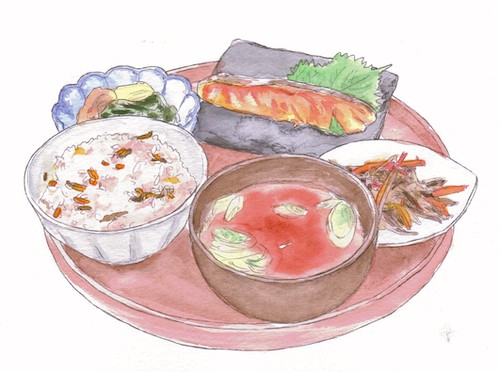
Better mindfulness will bring better health
I was with my parents, and we were at a Japanese restaurant somewhere in Tokyo. A rather small and humble place, with only a small sign out front that you’d probably miss had you not been looking for it. But once you stepped inside, you were welcomed with warm light, wooden paneling, a familiar “irasshaimase!” and an oshibori towel that made you feel instantly at ease.
We ordered a fantastic dinner course that I could describe in paragraphs of intricate detail, but perhaps what you’d find more interesting is what happened at the end — after a whole parade of beautiful vegetable, tofu, fish, and small plate dishes, to close the meal was a small bowl of rice and miso soup. No frills, no fuss, presented as simply as it is written.
I never understood why this is always the case. It’s not just this restaurant, but almost every Japanese dinner is done this way as well– the end is always a bowl of rice and soup. It’s a custom that’s also never really bothered me, for had we ordered al carte we probably would’ve ordered our dishes to come out in a similar order. Had I been eating at home, I probably would’ve done something similar, leaving a portion of rice and soup to be enjoyed at the end. But why is Japanese food eaten like this? Who started it, and why has it persisted as so?

The order in which to properly eat food, inspired by kaiseki-ryori
Turns out that the person responsible for this way of eating is Japanese shogun Ashikaga Yoshimitsu. He created a cuisine called honzen-ryori back in the 14th century, which prescribed a very elaborate way of serving food, to honor the tradition of mealtime and display wealth through beautiful, seasonal dishes. The cuisine had rules on amount, specific dishware, presentation, and actions to be taken during the meal. It was also from this cuisine where the concept of ichiju-sansai, or ‘one soup three sides’, was derived from.
Kaiseki-ryori, the version which is read with the Japanese kanji “event” (会席), simplified what honzen-ryori established by defining the types of dishes that should be served and in what order, but with the chef at liberty to use seasonal and local ingredients as they like, and present these dishes in a way which would compliment these ingredients.

*Kaiseki-ryori written as “懐石” refers to a different type of meal that is eaten before tea ceremonies, to best prepare the guest for tea consumption and Japanese confectionery. They are often accidentally used interchangeably.
The order of kaiseki-ryori
While kaiseki-ryori differs slightly in length and number of dishes dependent on intricacy of the course and discretion of the restaurant, it can generally be broken down into 10 different dishes:
- tsukidashi: a light appetizer, similar to amuse-bouche
- suimono: a light and refreshing clear soup
- hassun: a platter using seasonal ingredients and colors to set the tone of the course
- sashimi/otsukuri: a selection of fresh sashimi, dependent on location and seasonality
- takiawase: a selection of simmered vegetables, tofu, sometimes meat
- yakimono: something grilled, often fish
- nimono: something simmered, often vegetables
- shiizakana: a small bite of something either salty or pickled
- tome-wan: rice and miso soup, to finish the course
- mizumono: seasonal dessert, such as fruit or Japanese confectionery
Eventually the order in which these intricate meals were enjoyed found a place in the home. Using ideas of ichiju-sansai derived from honzen-ryori, and the order in which these foods should be enjoyed from kaiseki-ryori, many Japanese households are now accustomed to a similar way of eating.
First, a sip of miso soup to start
By taking a sip of soup first, you set the tone of the meal by starting off slow and patiently with the dish least likely to cause indigestion. It quiets any ravenous hunger or desire to rush through a meal, so you can be more mindful of chewing thoroughly when moving onto the next dishes.
Then, the whole foods which will fill you
The vegetables come next, as these dishes contain the most fiber and are the best at helping your body understand fullness. By having these foods be the first to digest, it prevents overeating later on in the meal and so you can stop at harahachi-bunme, or eight-tenths your stomach. This is balanced intermittently with the protein dish, where the protein and fat also help to signal fullness and provide a mindful context for the variety in flavor and food type in the meal.
Finish with a bowl of rice and soup, to cue the end of a meal
The carbohydrates are saved for last, after your body has already started breaking down earlier dishes, so you are no longer too hungry. This means you’ll finish the meal satisfied with just a small bowl of rice, a moderate single-serving portion, perhaps with a bite of pickles or furikake to top. The rest of the miso soup here helps to “wash everything down”, and allows you to finish the meal feeling full and satisfied, yet not overstuffed and bloated.

Better mindfulness will bring better health
While it might not make or break your health, the order in which you eat can have a profound effect on the way you experience harahachi-bunme and become aware of the variety of vegetables and food types you have a day — key ideas in establishing a healthful diet of moderation and balance. You end up eating a meal which is more reliant on vegetables or filling proteins, with a modest amount of carbohydrates to satisfy, and balance becomes more intuitive for your mind and body.
To make eating well a joyful aspect of your lifestyle, one without extreme self-restriction or unvarying bore, you don’t need to adopt a ten step course of kaiseki-ryori — but a bit of mindfulness on the order in which you eat can have waves of influence on your health and well-being.